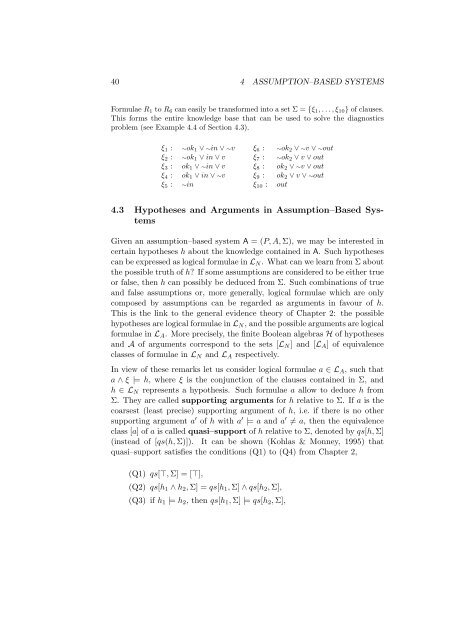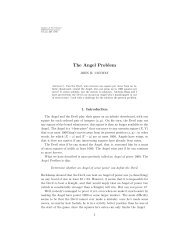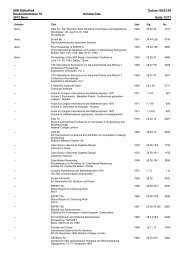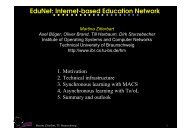Propositional Argumentation Systems and Symbolic Evidence Theory
Propositional Argumentation Systems and Symbolic Evidence Theory
Propositional Argumentation Systems and Symbolic Evidence Theory
Create successful ePaper yourself
Turn your PDF publications into a flip-book with our unique Google optimized e-Paper software.
40 4 ASSUMPTION–BASED SYSTEMS<br />
Formulae R 1 to R 6 can easily be transformed into a set Σ = {ξ 1 , . . . , ξ 10 } of clauses.<br />
This forms the entire knowledge base that can be used to solve the diagnostics<br />
problem (see Example 4.4 of Section 4.3).<br />
ξ 1 : ∼ok 1 ∨ ∼in ∨ ∼v ξ 6 : ∼ok 2 ∨ ∼v ∨ ∼out<br />
ξ 2 : ∼ok 1 ∨ in ∨ v ξ 7 : ∼ok 2 ∨ v ∨ out<br />
ξ 3 : ok 1 ∨ ∼in ∨ v ξ 8 : ok 2 ∨ ∼v ∨ out<br />
ξ 4 : ok 1 ∨ in ∨ ∼v ξ 9 : ok 2 ∨ v ∨ ∼out<br />
ξ 5 : ∼in ξ 10 : out<br />
4.3 Hypotheses <strong>and</strong> Arguments in Assumption–Based <strong>Systems</strong><br />
Given an assumption–based system A = (P, A, Σ), we may be interested in<br />
certain hypotheses h about the knowledge contained in A. Such hypotheses<br />
can be expressed as logical formulae in L N . What can we learn from Σ about<br />
the possible truth of h? If some assumptions are considered to be either true<br />
or false, then h can possibly be deduced from Σ. Such combinations of true<br />
<strong>and</strong> false assumptions or, more generally, logical formulae which are only<br />
composed by assumptions can be regarded as arguments in favour of h.<br />
This is the link to the general evidence theory of Chapter 2: the possible<br />
hypotheses are logical formulae in L N , <strong>and</strong> the possible arguments are logical<br />
formulae in L A . More precisely, the finite Boolean algebras H of hypotheses<br />
<strong>and</strong> A of arguments correspond to the sets [L N ] <strong>and</strong> [L A ] of equivalence<br />
classes of formulae in L N <strong>and</strong> L A respectively.<br />
In view of these remarks let us consider logical formulae a ∈ L A , such that<br />
a ∧ ξ |= h, where ξ is the conjunction of the clauses contained in Σ, <strong>and</strong><br />
h ∈ L N represents a hypothesis. Such formulae a allow to deduce h from<br />
Σ. They are called supporting arguments for h relative to Σ. If a is the<br />
coarsest (least precise) supporting argument of h, i.e. if there is no other<br />
supporting argument a ′ of h with a ′ |= a <strong>and</strong> a ′ ≠ a, then the equivalence<br />
class [a] of a is called quasi–support of h relative to Σ, denoted by qs[h, Σ]<br />
(instead of [qs(h, Σ)]). It can be shown (Kohlas & Monney, 1995) that<br />
quasi–support satisfies the conditions (Q1) to (Q4) from Chapter 2,<br />
(Q1) qs[⊤, Σ] = [⊤],<br />
(Q2) qs[h 1 ∧ h 2 , Σ] = qs[h 1 , Σ] ∧ qs[h 2 , Σ],<br />
(Q3) if h 1 |= h 2 , then qs[h 1 , Σ] |= qs[h 2 , Σ],








